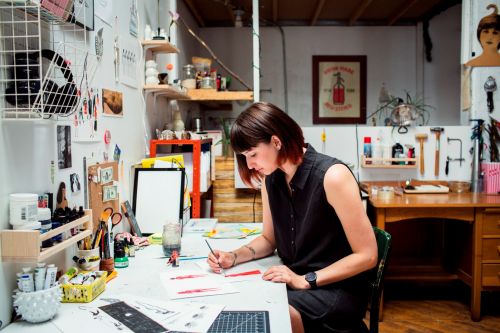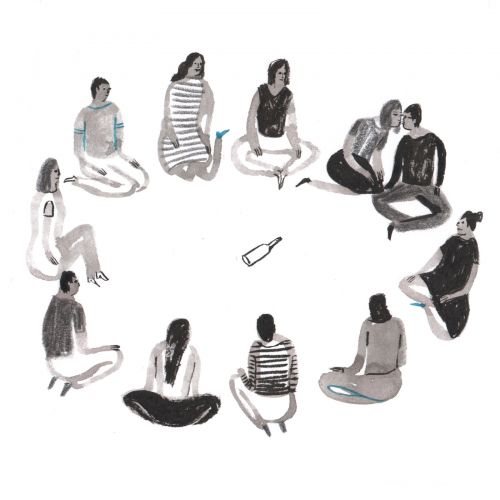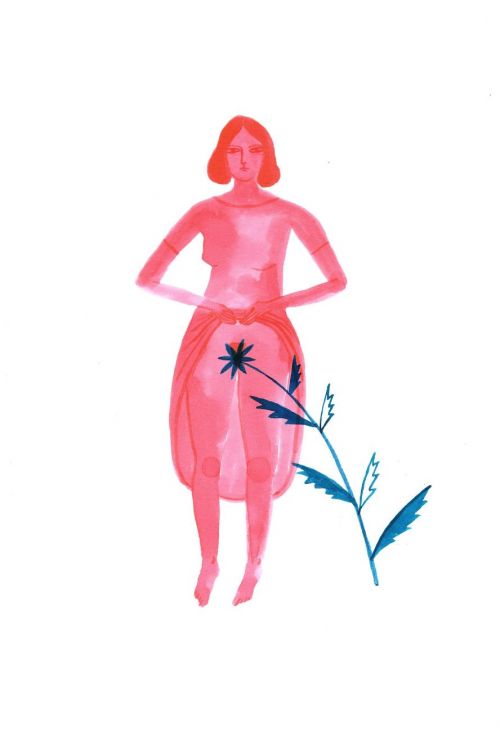From red body-suited rings of women on page 1, to a sinister wheel of fortune on page 128, Kaye Blegvad's illustration took over the Wheels Issue, and what a takeover it was. Her sweet-yet-sinister work also whirled our Cartwheels In a Box subscription parcel to life.
She spent an afternoon talking boobs and medieval art with Maggie Crow.
“I do seem to be having a naked lady phase.” Illustrator Kaye Blegvad is showing me around her Greenpoint studio. Formerly the boxing and labelling department of a pencil factory, the warehouse building has been turned into a workspace for Brooklyn creatives. Pens and ink litter the neatly-arranged desks and summer light floods through the windows.
Looking around I see evidence of Kaye’s myriad creative ventures: little plastic bags hold jewellery awaiting shipment, ceramic pots line the shelves, some filled with bright green succulents. Notably, boobs abound.

“I’ve always drawn tonnes of women but in the last couple years I’ve realised a weird power in the female body,” Kaye explains as she flicks the switch on a prototype for a sculpture, and two pairs of nipples light up. “There’s a lot of potential humour in it, too. A naked lady can be a serious political statement or it can be, ‘Yeah, I’m fun and naked. So what?’ There are options there that I like to play with.” With a tendency toward depictions of stoic women, the confrontation makes for a fantastic re-imagining of the naked lady trope. “A sexily reclining, angry-looking woman is something I enjoy a lot.”
Since graduating with a degree in illustration from the University of Brighton in 2010, Kaye has been remarkably busy for a young artist: not only taking commissions from the New York Times and Rookie magazine among others, but also turning her jewellery-making hobby into a successful small business, Datter, starting her own publishing house, Horizontal Press, and making highly covetable ceramics on the side.

You grew up in a house of artists, and your grandparents were artists as well. Is drawing something that you’ve been doing your whole life? Yes, it is. I’m a third-generation illustrator in my family. My grandfather was an illustrator, and his wife was a painter and a writer, and my dad is an illustrator, among other things. My mum is a painter. It’s in the blood somehow. Do we have a natural ability for it? It’s a struggle for all of us. We all wrestle with our abilities and think, “I’m awful, why am I doing this?” But I think there’s a kind of need there. We just have to. We’re doomed from birth to draw!
Do you feel that your style was influenced by your parents and grandparents? It was when I was younger. Now it’s more sensibilities than actual visual likeness. A lot of my dad’s work is pretty dark and weird and he’s into alchemy and surrealism and that definitely has rubbed off on me. My mum’s work is joyful; she does beautiful paintings, often quite abstract, and she has an incredible sense of pattern and colour. I don’t think it’s obvious in my work, but sometimes I’ll be doing things and think, “I totally stole this from mum.” She has a way of noticing beautiful little things, which is something that I try to do and has influenced how I make images.
What kind of little things does she notice? Nature is her religion. I’ll be walking down a gross street in Bushwick and find myself noticing a beautiful little weed, and I’ll think: that’s totally my mum noticing that for me. She would be able to take a photo of that, crop it in such a way to make it a gorgeous abstract image that suggested flowers. That’s not my process, but I really like noticing those little things from her.
Mixing that with my dad’s darkness and alchemy means that my work is somewhere in the middle. I don’t do body-horror, nightmare drawings—well, sometimes!—but my images aren’t pure joy and celebration. I like to think there’s a little bit of both of them.
 Kaye's illustration of Spin the Bottle, published in Issue 26.
Kaye's illustration of Spin the Bottle, published in Issue 26.
Could you tell me about the wheel of fortune illustration you made for the inside back cover? It’s based on an archetypal medieval image. I love medieval artwork, how the drawings are so simple but somehow they just nail it every time. This is the Goddess of Fortune, a big sinister woman turning a wheel that has people on it—mankind at the whim of this goddess. There’s something really satisfying about that image. It’s a nice idea to be—well, is it a nice idea or a terrifying idea, to be at the whims of fortune?—but I felt like it was an interesting concept. I based it on a medieval illumination, but I wanted the figures to be more ambiguous. Maybe they’re just going round and round. The goddess isn’t evil, she’s not malicious. She might just want to give you a spin.
The way I understand it, your work is broken down into ceramics, jewellery and print work. Is that right? I work in a lot of different mediums and I like that a lot. I like being able to bounce between things. All of the work is drawing-based and my process is pretty analogue—inks and watercolours and straight onto paper where possible—but often there will be little things that I’ll add digitally. I’ll draw things in two or three pieces and then collage them together. It means that I have a lot of pieces of drawings, which is hard if you have to exhibit something because the images don’t really exist!
I have a lot of zine or small artist book projects on the go, but I often struggle with self-initiated things when there’s no deadline and it’s just my say-so. It’s nice to make things into a business or something more real than just ‘the personal work of Kaye Blegvad’. I like having reasons to make stuff beyond just self-amusement, sometimes.
Is self-amusement a big part of what drives you? A lot of my drawings are self-amusement, definitely. And things that I think are funny. Then I’ll show them to other people and they’ll be like, “This is sad and terrible!” and I’ll be like, “No, it’s hilarious, it’s clearly a joke!” My stuff goes dark faster than I expect it to. I was in a group exhibition a few weeks ago and the theme was Girls of Summer, but basically the theme was boobs (girls being a play on ‘the girls’). I’m never one to turn down drawing boobs, so I drew some girls and a big fruit tree, but instead of fruit there were boobs and the girls were picking boobs from the tree. I thought it was funny, so I showed it to some friends and some of them were absolutely horrified! Depending on your perception when looking at it, you could think, “Eugh! This is a nightmare world where women have to pick their own boobs!” But no, it’s supposed to be funny. Pick a huge, juicy boob off a tree and laugh about it.
Kaye Blegvad / www.kayeblegvad.com

